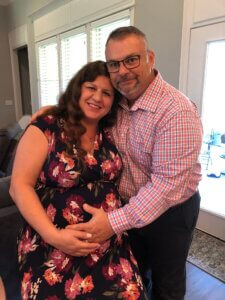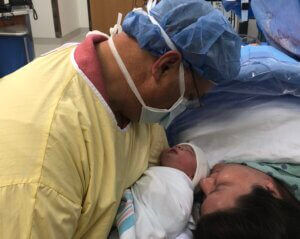Their journey required a miracle. They got two.

When Ashley and Mark first decided to start a family, they knew they would be looking for a miracle. They were dealing with several issues that would make their odds of getting pregnant slim: Ashley’s age, endometriosis and adenomyosis. But, Ashley is now pregnant with her second miracle, thanks to the science of in vitro fertilization and a fertility specialist determined to help them find success.
Age and a history of endometriosis was working against them
The Baton Rouge couple met on the job. Ashley was a flight nurse and Mark a paramedic. Ashley was already in her late 30s and Mark was 10 years older when they fell in love, decided to marry and have a family. When they started trying to get pregnant in early 2019, the couple understood their journey to building a family would be more difficult due to age. Both in the medical field, they knew because they were older they couldn’t waste any time. Also, a prior surgery to remove a cyst had revealed that Ashley had endometriosis which explained the heavy bleeding and mood swings she always had during her cycles. And, to complicate matters even more, her gynecologist suspected a uterine fibroid, another possible complication to getting pregnant.
On their first visit to see Dr. Neil Chappell, reproductive endocrinologist at Fertility Answers Baton Rouge, they discussed their chances of Ashley getting pregnant at 37 and how age can impact the quantity and quality of a woman’s eggs. Dr. Chappell also performed an ultrasound which revealed what looked like a fibroid in a portion of the uterus that would make keeping a pregnancy difficult.
During surgery, Dr. Chappell quickly realized that what looked like a fibroid on ultrasound was in reality an adenomyoma, a tumor-forming variant of adenomyosis, a benign gynecological condition in which endometrial glands form in the muscular wall of the uterus. In Ashley’s case, her adenomyosis neatly organized into a ball that was able to be surgically removed. He also confirmed her diagnosis of Stage 3-4 endometriosis. More unexpectedly, he needed to remove one of her fallopian tubes due to a hydrosalpinx caused by the endometriosis.
Waking up from surgery and learning about the loss of her fallopian tube and the adenomyosis, Ashley remembers how extremely depressed and sad she was at the time. “I wanted to be a mom more than anything in the world. Now my chances of getting pregnant were even more slim,” she recalls. Ashley was ready to give up at this point. But Mark urged her on. “I knew if we didn’t follow through with treatment, we would always wonder ‘what if’,” he says.
At their post-op consultation, Dr. Chappell gave the couple some hope that they could one day be parents. Their best chance of conceiving due to her age, loss of her tube and the endometriosis would be through IVF, he told them. And through some medical suppression of the endometriosis and adenomyosis, their chances could improve. He recommended they begin with an egg retrieval cycle soon to bank as many embryos as possible.
One embryo gave them exactly one chance

After 3 to 4 months of healing post-surgery, Ashley began stimulating her ovaries with daily injections to produce multiple eggs in preparation for an egg retrieval. She and Mark were initially excited when they learned Dr. Chappell was able to retrieve 5 eggs. But that excitement soon fizzled as they learned that only two eggs fertilized normally and only one made it to the blastocyst stage. “We had taken out a hefty loan to pay for treatment,” says Ashley, “and with just one embryo, we knew this was our one chance.” Going all or nothing, the couple decided not do any more egg retrievals and go straight to a transfer.
After several months of cancelled transfers due to various reasons, they were finally scheduled for their embryo transfer in mid-March 2020, over a year after they had begun their journey. Then COVID-19 struck and all unnecessary medical procedures in the state were ordered to cease. Luckily, they were allowed to go through with the transfer since Ashley had already started her medication in preparation for it. On March 19, 2020, under strict COVID protocols, that one remaining embryo was transferred to her uterus.
They were in complete shock when they realized Ashley was pregnant two weeks later. That one little embryo was going to become their miracle baby. In December 2020, Amelia was born via c-section.
Giving it another chance

About nine months after Amelia’s arrival, Ashley and Mark decided to test their luck again. “I knew I wanted Amelia to have a sibling. I felt this in my heart that it was what I needed to do,” says Ashley. Financially, the couple was in a good place to afford another cycle. And Ashley had also switched jobs to be a hospice nurse so she would have more time to be a mom.
Starting all over with a new IVF cycle, only three eggs were retrieved this time, of which two made it to the blastocyst stage. The couple was both encouraged and disappointed. Two embryos were better than one. But, their chances were still slim. “We anticipated this going in,” says Ashley. “I was 40 years old and my AMH was significantly lower than the first time around.”
With two possible embryos this time, Dr. Chappell recommended that they use PGT-A, preimplantation genetic testing, to help determine which embryo to transfer. “I was determined I would do everything to give Amelia a sibling,” says Ashley, “and because I was now over 40, this really did feel like an absolute last chance.” Embryo testing revealed that only one of the embryos was normal, adding to the concreteness of their situation.
Ashley and Mark transferred their “last chance” embryo in November 2022. They are still wrapping their heads around how lucky they were a second time as Ashley enters her second trimester with a second miracle due in July.
“We couldn’t have had these two miracles without Dr. Chappell,” says Ashley. “We absolutely love him. He is so transparent, honest, and willing to go above and beyond for his patients.” They also want others to hear their story and feel hope. “We knew how slim our chances were when we first started all of this,” says the couple. “Twice we almost didn’t go through with it. We hope our story offers hope to others that might be in a similar situation as ours. Technology has come so far and we would hate to see anyone give up.”


